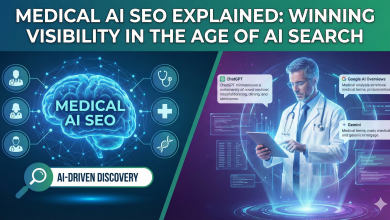
For decades, SEO followed a familiar formula: research a query, analyze a list of blue links, optimize to rank first. That model is breaking. With AI search engines like ChatGPT, Perplexity, and Claude reshaping discovery, brands must rethink what it means to be found. Traditional SEO tactics still matter, but they are no longer enough. Visibility now extends beyond the SERP, into a world where bots, agents, and AI-powered assistants decide what information consumers see first.
GEO vs. SEO: The Acronym Wars That Don’t Matter
The search industry loves debating SEO versus GEO (Generative Engine Optimization) versus AEO (Answer Engine Optimization). But the reality is simple: your consumers don’t care about acronyms. They care about answers. Whether they’re typing into Google, prompting ChatGPT, or asking Alexa, you need to make sure your content and products are surfaced everywhere they search.
For years, brands churned out content to game algorithms, like recipe blogs stuffed with irrelevant keywords and articles designed for crawlers instead of customers. That approach doesn’t just fail in the AI era — it hurts your visibility. Today’s AI models are parsing intent, context, and authority. You need content that directly answers your audience’s questions and delivers value, not filler.
AI Search Changes the Rules of Discoverability
AI platforms are “learning” in multiple ways, and it’s redefining how visibility works. AI engines crawl sites not just for indexing, but also to train LLMs and to enhance their responses with retrieval-augmented generation (RAG), combining existing knowledge with real-time data. They don’t crawl to rank— they crawl your site to find and summarize new and high-quality content for consumers.
Recent data shows AI-driven crawls more than doubled from January to June, rising from 20 million to 45 million per day. In some industries, AI bot traffic now surpasses human traffic. And now, bot traffic can even convert: agents can use your content to help consumers discover, consider, compare, and even purchase products on AI platforms, all without driving a single click. This shift makes structured, semantically rich, intent-aligned content critical.
From Clicks to Context: Rethinking KPIs
When agents do the clicking for the consumer, traditional SEO metrics such as rankings, backlinks, and traffic lose some of their relevance. The new KPI is contextual visibility. Ask yourself: 1) Are you cited in AI-generated summaries? 2) Is your information being relayed accurately? 3) Does your brand surface in conversations, even when consumers don’t search for you directly?
Combining log file analysis with traditional analytics can reveal how AI bots engage with your site. Soon, expect to measure share of voice across AI platforms, citation frequency, and presence inside AI-driven responses.
The New AI Optimization Playbook
Brands need to approach optimization with a broader lens: 1) Run an AI technical audit: Can your infrastructure handle large-scale bot traffic? 2) Conduct a content intent audit: Which high-value pages are being crawled and cited? 3) Where is structured data missing? It’s also important to break down silos: AI search touches every part of marketing. PR, content, SEO, paid, and social must work together under one AI visibility strategy.
GEO isn’t replacing SEO — it’s elevating it to new heights. The technical foundation remains, but the mindset shifts: you’re no longer optimizing for algorithms; you are training AI.
What’s Next
AI search is rewriting the rules of discoverability. Winning is not about topping the SERP anymore; it’s about being included in the conversation. The brands that structure content for bot-friendly interpretation, align it with intent, and adapt their measurement strategies will thrive in this AI-first era.
Whatever you call it, SEO, GEO, or AEO, the goal is the same: be everywhere consumers seek answers, and get there faster, smarter, and using fewer resources. In a search landscape driven by AI, visibility is strategy.



